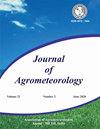利用谷歌地球引擎,通过卫星得出的马拉瓦达地区作物水分胁迫指数(CWSI)评估作物水分胁迫情况
Q3 Agricultural and Biological Sciences
引用次数: 0
摘要
作物需水量的准确信息对作物的最佳生长和产量至关重要。适时评估这些信息,尤其是在需水量最大的植株期和生育期,对作物的成功生产至关重要。我们的研究以易受干旱影响的马拉瓦达(Marathwada)地区为研究对象,具体针对 2015 年至 2020 年,包括具有挑战性的 2015 干旱年和有利的 2020 年。使用作物水分胁迫(CWSI)指数检测作物水分胁迫,并与卫星数据得出的归一化差异植被指数(NDVI)和归一化差异湿度指数(NDWI)进行比较。我们的研究结果表明,CWSI 与卫星得出的植被指数 NDVI 和 NDWI 之间存在负相关。值得注意的是,与 NDVI 相比,NDWI 指数与 CWSI 的一致性更强。在干旱或降雨不足的年份,如 2015 年、2017 年和 2019 年,这种相关性表现得尤为稳健,而在 2016 年、2018 年和 2020 年,则观察到较弱的相关性。此外,这些相关性在不同降雨区内的不同地区显示出差异。本文章由计算机程序翻译,如有差异,请以英文原文为准。
Evaluating crop water stress through satellite-derived crop water stress index (CWSI) in Marathwada region using Google Earth Engine
Accurate information of crop water requirements is essential for optimal crop growth and yield. Assessing this information at the appropriate time, particularly during the vegetative and reproductive stages when water demand is highest, is crucial for successful crop production. Our study cantered on the drought-prone Marathwada region, specifically targeting the years 2015 to 2020, encompassing the challenging drought year of 2015 and the favourable year of 2020. The crop water stress was detected using crop water stress (CWSI) index and compared with normalized difference vegetation index (NDVI) and normalized difference wetness index (NDWI) derived from satellite data. Our findings reveal a negative correlation between the CWSI and satellite derived vegetation indices NDVI and NDWI. Notably, the NDWI index exhibits stronger alignment with CWSI compared to NDVI. The correlation demonstrates particular robustness during drought or deficient rainfall years such as 2015, 2017, and 2019, while weaker correlations are observed in 2016, 2018, and 2020. Moreover, these correlations display variations across different areas within distinct rainfall zones.
求助全文
通过发布文献求助,成功后即可免费获取论文全文。
去求助
来源期刊

Journal of Agrometeorology
农林科学-农艺学
CiteScore
1.40
自引率
0.00%
发文量
95
审稿时长
>12 weeks
期刊介绍:
The Journal of Agrometeorology (ISSN 0972-1665) , is a quarterly publication of Association of Agrometeorologists appearing in March, June, September and December. Since its beginning in 1999 till 2016, it was a half yearly publication appearing in June and December. In addition to regular issues, Association also brings out the special issues of the journal covering selected papers presented in seminar symposia organized by the Association.
 求助内容:
求助内容: 应助结果提醒方式:
应助结果提醒方式:


